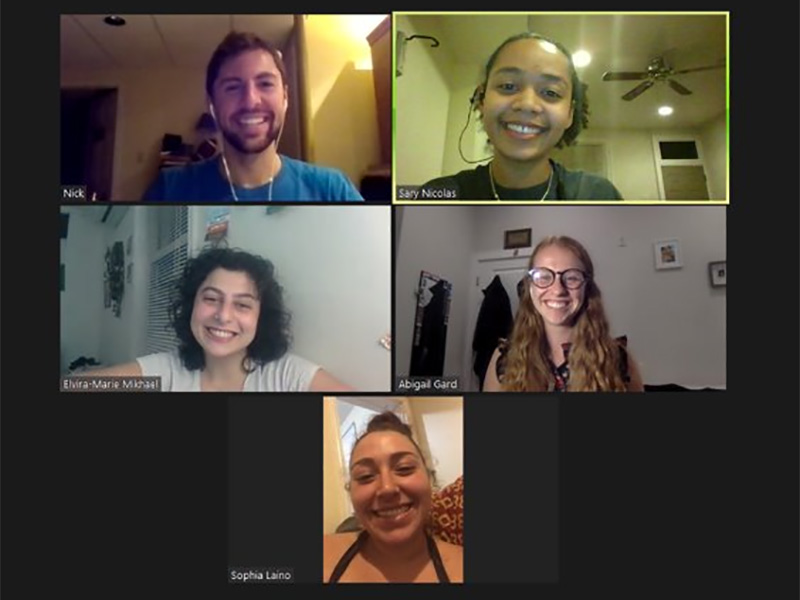As one of the hallmarks of a Drexel Engineering education, senior design can have an impact on multiple levels. Some teams turn their project into their own business. Others find a passion that catapults them to post-graduate study.
For a team of civil, architectural and environmental engineering students, senior design is a chance to make an impact on the world.

Members of senior design team meeting on Zoom.
The team — Elvira-Marie Mikhael, Abigail Gard, Sophia Laino, Sary Nicolas, and Nicholas Paparo — partnered with Anand Gopal and his team at the Zomia Center, a nonprofit that studies ungoverned and semi-governed spaces, to design a community center and football (soccer) fields in Manbij, Syria.
The project was born when the team’s advisor, Distinguished University
Professor Joseph Hughes, PhD, reached out to Gard while working together
for one of her co-op experiences.
“He told us about work he was doing with Anand Gopal and the Zomia Center
and suggested we all meet. Anand is currently writing a book on the Syrian
civil war and a chapter on the importance of football to the communities
there. He was interested in what it would be like, as a form of
reconciliation, if you were to drop a football field in the middle of a
neighborhood that had been deeply impacted by the war.”
After researching the idea, the team decided to add a design for a community center to the wish list, knowing that it could offer a wide variety of services to the area. They say that, after the years of unrest in Manbij, it was worth the extra planning.

This site in Manbij with 100% damage is considered completely leveled and uninhabitable. A location like this would be where development of the project would be prioritized.
“Within five years of the civil war breaking out in 2011, the city was under the control of four different factions,” Paparo says. “We talked to one man who told us he was afraid to go to the bakery across the street because it was run by one of his torturers, a member of ISIS. But since 2016, the Syrian Democratic Forces have been able to stabilize the city with the help of the United States and other allies. Now is a good time to go in and figure out how to build the area back stronger than it was.”
To gain insight for their plan, the team met with stakeholders and used existing surveys filled out by residents of the area. It helped them identify important issues like considering how to accommodate for accessibility when there isn’t a guarantee of consistent electricity to run an elevator. They also wanted to design a building that could withstand any future fighting.
“We wanted to make sure we weren’t designing a bunker — it had to be inviting and accessible — but it still needed to be blast safe for times of crisis,” Mikhael says. “So, we designed our basement to be used as a multifunctional meeting space with movable chairs and a movable stage so that a large number of people can gather there for safety.”

Renderings of the project design. The community center holds a kitchen, reading space, two classrooms, bathrooms and tables for collaborative work. Outside the center, there is space for community gardens, picnic tables and green space.
Beyond the humanitarian implications of the projects, the team says that it taught them to broaden the ways they used the skills they had learned in the classroom.
“Naturally, we did a lot structural engineering, but there was much more to it than that,” Gard says. “There was geotechnical engineering, transportation engineering, site engineering… we really tried to cover almost every single sub-sector of civil engineering in this project, which I also think, made it really interesting.”
The project also gave the team an opportunity to develop contextual skills that will help them in their careers.
“We were also able to do things that weren't necessarily engineering in this project —understanding of history and understanding of socioeconomic status, plus community-driven design in terms of asking questions and getting background on what is needed and wanted in the area,” Mikhael says. “That's something that I didn't think I would be able to do, and I'm glad that I had the chance because it gave me the opportunity to see a different side of engineering design that I wouldn't have been able to otherwise.”
With the design complete, the next step is trying to make the complex a
reality.
“Our work serves as a concept model that will be taken back to the
community for further feedback and input,” Gard says. “Anand will take what
we have produced and use it to apply for grants with the hopes of getting
the complex constructed in the coming years. Through the grant funds or
generous pro-bono work, licensed engineers can expand upon our work and
make our vision come to fruition.”